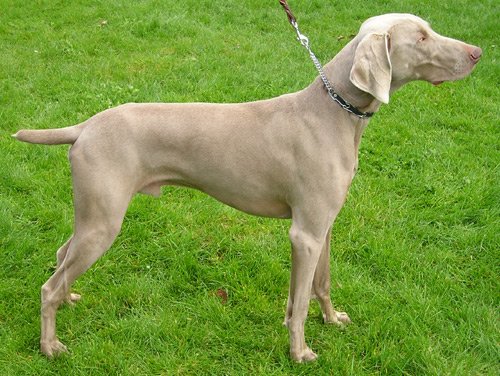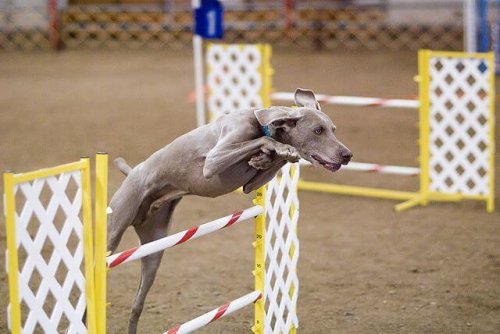The Weimaraner
5 minutes

Last update: 02 August, 2018
The Weimaraner is an agile, athletic dog that has an elegant poise and velvet-colored fur. This bread has an intelligent, constantly vigilant look on its face. However, behind those bright eyes is a dog breed with a great personality. Below, you can learn all about the Weimaraner.
Origins of the Weimaraner
Many people have speculated about the Weimaraner’s origins, but the only thing we know for certain is that it´s a descendant of German hunters. Its bloodline has been kept pure even before other dog breeds were created, due to its great value as a hunter. In fact, the breed has remained pure, and hasn’t been crossed with other breeds since 1900.
The Weimaraner was such a good hunter that it was exclusively bred for nobility. It specialized in hunting big game, which is why it’s larger and more fierce than other dogs.
Note that over time it was also taught to hunt small prey. That was the moment when it became a pointer. Currently, the World Canine Organization (FCI) classifies it within Group 7.
Today the Weimaraner is an extraordinarily energetic and intelligent dog. They are rescue dogs, and participate in hunting and sports competitions. However, they are also great pets in many homes.

Traits
The Weimaraner is a medium-sized to large breed dog. Males measure between 60 and 70 cm in height, while females measure between 55 and 65 cm. As for weight, both sexes can weigh in between 25 and 40 kilos.
The Weimaraner is a slender dog with an agile appearance, due to its thin but strong and muscular body. Its body is slightly longer in proportion to its height. Its snout is also longer in comparison to the size of its skull, and his skull’s doesn’t really curve that much. This breed’s chest is deep but not wide, which helps give it a strong and athletic appearance.
On the other hand, this breed has interesting wide, long ears that droop down on the sides of its head. These are typical in pointers.
Also, the most well-known variety of this breed are the dogs that have short, grayish hair. From a long distance, they stand out for their beauty and soft-looking hair, even though they actually have stiff, dense hair.
Plus, there is another variety that has long hair. Its fur is softer, and the longer hair is located on the ears, tail, and lower part of the body (between the neck, chest and belly). This dog, on the other hand, can have gray, grayish- brown or bluish gray fur.
In order for the FCI to approve a dog as a certain breed, it must pass a working test. Therefore, a dog can’t be categorized as this breed just by its appearance alone.
Behavior
The Weimaraner is a versatile dog that adapts well to many different types of jobs. It’s a very trainable dog if you are consistent and know how to do it correctly.
Likewise, a positive aspect that you should know about is that this dog is sociable and affectionate with its family, but it can be shy or suspicious of strangers. For this reason, it is especially important to socialize this breed when they’re still a puppy. People also say they make good guard dogs, although they don’t show aggression while watching over the house.
The Weimaraner is also well known for its great intelligence. In addition, it’s a very energetic dog, so it needs both mental and physical exercise. Therefore, this breed is used for rescue units or emergencies, or canine sports such as agility competitions.

This dog has a strong hunting instinct, so you shouldn’t use toys that incite it to chase or hunt. They also love searching and following scent trails.
They tend to be extremely happy and mentally stable dogs in the countryside or in small towns. However, they don’t enjoy life in the city. Cities have too many stimuli for a dog that is always ready to work or hunt, and they offer little mental stimulation.
Therefore, developing a Weimaraner’s intelligence is important for its well-being. Also, it gets overwhelmed when there isn’t enough space to run and sniff around, as it would have while hunting in the woods.
So, the ideal family for a happy Weimaraner is one that likes to go hiking in the mountains and take long walks with their dog. You shouldn’t have your Weimaraner live an apartment or city, even though this breed can adapt to one.
Care
The Weimaraner’s short hair makes it very easy to care for and to keep healthy. Brushing them once a week is enough. Nonetheless, you should brush it more during molting seasons (spring and fall).
As for diseases, not many are common in this breed. However, the most common medical conditions are hemophilia A, and problems with blood clotting in the eyelids. Therefore, they should have veterinarian checkups on a regular basis to address health problems that large breeds and dogs with droopy ears have. For example, hip dysplasia, mites, fungi, eye problems or ear infections.
Since you should take this dog for walks in the forest, be careful of any thorns that could get stuck on its paw pads. Also, make sure you thoroughly deworm your dog, internally and externally.
The Weimaraner is a dog that stands out for of its physical appearance and personality. It’s beautiful and at the same time it’s intelligent and hard-working. So, if you are able to give this dog the mental and physical exercise it requires, your Weimaraner will make you happy for many years.
This text is provided for informational purposes only and does not replace consultation with a professional. If in doubt, consult your specialist.